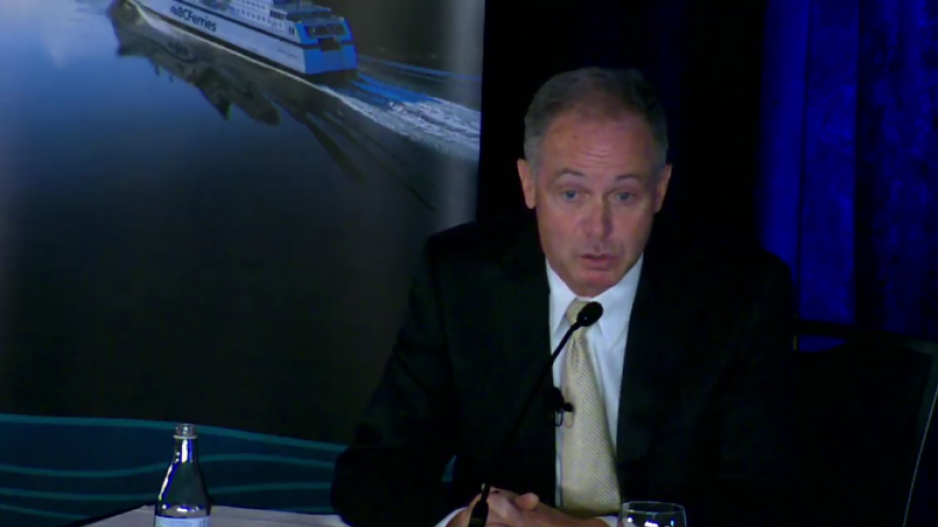BC Ferries president Mark Collins says the company expects to be back to pre-COVID capacity levels across the system starting Sept. 7.
“That’s good progress when you consider the cliff that we’ve come through,” he said. “We would have liked it to have been faster, but it’s reasonable and prudent… We’re grateful to be at this stage.”
Collins made the comments at the BC Ferries annual general meeting, held Aug. 20 in front of limited crowd in Victoria and streamed online.
He also said BC Ferries will join other transit companies in moving to a mandatory mask policy. Up until now, travellers had to carry a mask but were not required to wear it on board unless they were in an area where distancing wasn’t possible.
“When people are travelling on the BC Ferries system, on a terminal or a ship, they must wear a mask,” Collins said. “There are certain key exceptions. If you’re in your car or eating in a designated area [or] if you’re outside and you can be sure of maintaining distance, that’s OK. But if you’re in the interior of our ships or terminals it will no longer be discretionary; it will be mandatory.”
Collins said an official announcement would come later this week.
Just prior to the AGM, BC Ferries released its first quarter results coving the period April 1 to June 30.
Ferries said revenue for the quarter was $137.4 million, down $109 million year-over-year, a loss that was partially offset by reductions in expenses of $36.7 million compared to the first quarter of last year.
Among those lower expenses was the cost of salaries, wages and benefits, which dropped from $101.3 million for the first quarter of 2019 to $89.7 million. The ferry company also spent $8.6 million less on fuel in the first quarter of this fiscal year than it did over the same period last year.
The $62-million net loss compares to net earnings of $12.2 million for the first quarter of 2019.
BC Ferries did not release details for individual routes, but said on the four major routes, which include Langdale-Horseshoe Bay, there were 44 per cent fewer sailings and the ships carried 53 per cent less vehicle traffic and 68 per cent less passenger traffic.
In the management discussion and analysis document filed as part of the quarterly report, the company said it averaged $77.49 per vehicle on the major routes, 18 per cent more than it had in the first quarter of last year, “mainly as a result of a change in the traffic mix (increased commercial traffic with higher tariffs) and a higher proportion of vehicles travelling with a reservation.”
The result was a decrease of $71.8 million in revenue from fares on majors and a drop of $83.7 million across all routes, as well as decreases in revenue from parking, catering and on-board services.
The company also noted in the management discussion and analysis that as of Aug. 11, BC Ferries was included in the federal-provincial safe start agreement, which sets aside $1.08 billion for transit.
“Over the past few months, BC Ferries has been working closely with the province, having formed a task force to collaboratively work together on strategic options to sustain the ferry system for the long term,” the company said.
While BC Ferries continues to report losses, the BC Ferry and Marine Workers Union (BCFMWU) launched a “More Sailings, More Service” campaign Aug. 17, urging British Columbians to write their MLAs and MPs to demand governments “step up to fix this long term” with increased funding.
BCFMWU member Karli Davies, the campaign spokesperson for the Sunshine Coast, said more funding is key to the future of the Langdale-Horseshoe Bay route.
“We're not a self-sufficient community. You have to travel for medical appointments for specialists, we have commuters that travel, including essential workers. We also have youth that have to travel for sports teams and post secondary education,” Davies told Coast Reporter. “Our union feels that this is definitely a key area that is suffering from the lack of service right now.”
Davies said the union welcomed the announcement of funding through the federal-provincial safe start agreement, but the “More Sailings, More Service” campaign is looking at the long term.
“We think right now is the best time to invest,” Davies said. “The Sunshine Coast won’t survive if we don't improve the service level… The needs weren’t even being met pre pandemic.”
Davies said the union is hoping the campaign, which she said has had a good response so far, gains traction outside ferry-dependent communities as well. “We want to raise awareness not just of our coastal residents, but also the people who live in Vancouver and inland as well, because everyone benefits from the service levels being improved.”




